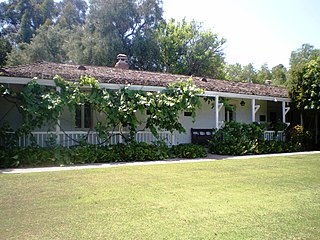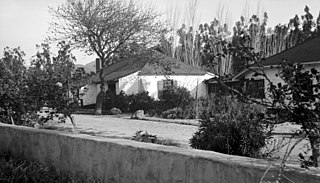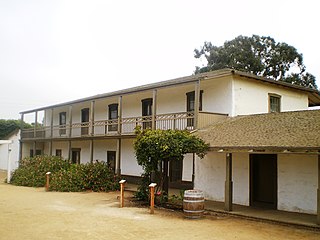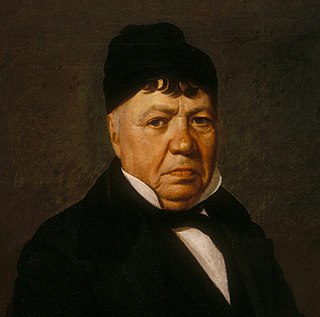
Rancho Cucamonga was a 13,045-acre Mexican land grant in present-day San Bernardino County, California, given in 1839 to the dedicated soldier, smuggler and politician Tiburcio Tapia by Mexican governor Juan Bautista Alvarado. The grant formed parts of present-day California cities Rancho Cucamonga and Upland. It extended easterly from San Antonio Creek to what is now Hermosa Avenue, and from today's Eighth Street to the mountains.

The Centinela Adobe, also known as La Casa de la Centinela, is a Spanish Colonial style adobe house built in 1834. It is operated as a house museum by the Historical Society of Centinela Valley, and it is one of the 43 surviving adobes within Los Angeles County, California. The Adobe was the seat of the 25,000-acre (100 km2) Rancho Aguaje de la Centinela, a Mexican Alta California-era land grant partitioned from the Spanish Las Californias era Rancho Sausal Redondo centered around the Centinela Springs.

The Las Flores Estancia was established in 1823 as an estancia ("station"). It was part of the Spanish missions, asistencias, and estancias system in Las Californias—Alta California. Las Flores Estancia was situated approximately halfway between Mission San Luis Rey de Francia and Mission San Juan Capistrano. It is located near Bell Canyon on the Camp Pendleton Marine Corps Base ten miles south of the City of San Clemente in northern San Diego County, California. The estancia is also home to the architecturally significant National Historic Landmark Las Flores Adobe, completed in 1868.

Rancho Camulos, now known as Rancho Camulos Museum, is a ranch located in the Santa Clara River Valley 2.2 miles (3.5 km) east of Piru, California and just north of the Santa Clara River, in Ventura County, California. It was the home of Ygnacio del Valle, a Californio alcalde of the Pueblo de Los Angeles in the 19th century and later elected member of the California State Assembly. The ranch was known as the Home of Ramona because it was widely believed to have been the setting of the popular 1884 novel Ramona by Helen Hunt Jackson. The novel helped to raise awareness about the Californio lifestyle and romanticized "the mission and rancho era of California history."

The Olivas Adobe in Ventura, California is an adobe structure built in 1837 by Raymundo Olivas on the north bank of the Santa Clara River about a mile from the estuary where it flows into the Santa Barbara Channel.

José Antonio de la Guerra y Noriega was a Californio military officer, ranchero, and founder of the prominent Guerra family of California. He served as the Commandant of the Presidio of Santa Barbara and the Presidio of San Diego.

Rancho Petaluma Adobe is a historic ranch house in Sonoma County, California. It was built from adobe bricks in 1836 by order of Mariano Guadalupe Vallejo. It was the largest privately owned adobe structure built in California and is the largest example of the Monterey Colonial style of architecture in the United States. A section of the former ranch has been preserved by the Petaluma Adobe State Historic Park and it is both a California Historic Landmark and a National Historic Landmark. The Rancho Petaluma Adobe State Historic Park is located on Adobe Road on the east side of the present-day town of Petaluma, California.
Rancho Santa Maria de Los Peñasquitos was a 8,486-acre (34.34 km2) Mexican land grant in present-day southwestern San Diego County, California given in 1823 to Francisco María Ruiz. The name means "Saint Mary of the Little Cliffs". It encompassed the present-day communities of Mira Mesa, Carmel Valley, and Rancho Peñasquitos in northern San Diego city, and was inland from the Torrey Pines State Natural Preserve bluffs.

Rancho Los Encinos was a Spanish grazing concession, and later Mexican land granted cattle and sheep rancho and travelers way-station on the El Camino Real in the San Fernando Valley, in present-day Encino, Los Angeles County, California. The original 19th-century adobe and limestone structures and natural warm springs are now within the Los Encinos State Historic Park.

Los Cerritos Ranch House, also known as Rancho Los Cerritos or Casa de los Cerritos, in Long Beach, California, was "the largest and most impressive adobe residence erected in southern California during the Mexican period". Los Cerritos means "the little hills" in English. It was declared a National Historic Landmark in 1970. It is currently a museum.
Rancho San Jose was a 22,340-acre (90.4 km2) Mexican land grant in northeastern Los Angeles County given in 1837 by Governor Juan Bautista Alvarado to Ygnacio Palomares and Ricardo Véjar. Today, the communities of Pomona, LaVerne, San Dimas, Diamond Bar, Azusa, Covina, Walnut, Glendora, and Claremont are located in whole or part on land that was once part of the Rancho San Jose.

La Casa Alvarado, also known as the Alvarado Adobe, is a historic adobe structure built in 1840 and located on Old Settlers Lane in Pomona, California. It was declared a historic landmark in 1954 and added to the National Register of Historic Places in 1978.
Rancho Los Álamos was a 48,803-acre (197.50 km2) Mexican land grant in present-day Santa Barbara County, California given in 1839 by Governor Juan Alvarado to José Antonio de la Guerra, a son of José de la Guerra y Noriega. Los Álamos is Spanish for "the cottonwoods" and describes Frémont's Cottonwood (Populus fremontii) trees lining the banks of the San Antonio Creek.

Rancho Santa Ana del Chino was a 22,193-acre (89.81 km2) Mexican land grant in the Chino Hills and southwestern Pomona Valley, in present-day San Bernardino County, California.

Rancho Las Vírgenes was a 17,760-acre (71.9 km2) land grant in the Santa Monica Mountains and Simi Hills, in present day western Los Angeles County, California. The lands of the Rancho Las Vírgenes included present day Agoura Hills, Oak Park, and Westlake Village and part of the Santa Monica Mountains.
Rancho El Conejo was a 48,572-acre (196.56 km2) Spanish land grant in California given in 1803 to Jose Polanco and Ygnacio Rodriguez that encompassed the area now known as the Conejo Valley in southeastern Ventura and northwestern Los Angeles Counties. El Conejo is Spanish for "The Rabbit", and refers to the many rabbits common to the region. The east-west grant boundaries approximately went from the border of Westlake Village near Lindero Canyon Road in the east to the Conejo Grade in the west. The north-south borders extended from the top of the Simi Hills at the end of Moorpark Road in the north to Hidden Valley in the Santa Monica Mountains in the south. The rancho is the site of the communities of Newbury Park, Thousand Oaks, and Westlake Village.
Rancho Santa Rita was a 8,894-acre (35.99 km2) Mexican land grant in the Amador Valley and western Livermore Valley, which is in present day Alameda County, California.
La Casa de Carrión is an Adobe home built in 1868 by Saturnino Carrión. It is currently located in La Verne, California. The La Casa de Carrión was designated a California Historic Landmark on Dec. 14 1945. When La Casa de Carrión was built it was on the Rancho San Jose land. The Casa de Carrion the land was owned by Carrion's uncle Ygnacio Palomares and his business partner Ricardo Vejar. Ygnacio Palomares had built his own home, Ygnacio Palomares Adobe, near by in what is now Pomona, California in 1855. The land of Casa de Carrion was gifted to Saturnino Carrión by Ygnacio_Palomares. The adobe home was built in a "L" shape with the front of the house facing north. Saturnino Carrión, his wife, Dolores, and their three sons moved into La Casa de Carrión at completion. The three sons were: Ramon del Refugio, Julian and Frank. Saturnino and Dolores married on 15 May 1865 at the Plaza Church in Pueblo Los Angeles. Born at La Casa de Carrión to Saturnino and Dolores were daughters: Josefa, Agatha and Louise. Saturnino Carrión raise livestock on his ranch at La Casa de Carrión. Saturnino Carrión grew up in the City of Los Angeles, the only child of Casiano Carrión and Josefa (Lopez) Carrión. Julian continued to run the ranch after his father died.

José Manuel Boronda, was the first ranchero settler in Carmel Valley, California. He and Vicente Blas Martínez were given the 6,625-acre (26.81 km2) Rancho Los Laureles Mexican land grant in present-day Monterey County, California on September 20, 1839, by Governor Juan Alvarado. Many of the Boronda historic sites still exist, including the Los Laureles Lodge, Carmel Valley Village, Road-Boronda Road Eucalyptus Tree Row, Manuel Boronda Adobe (1817), José Manuel Boronda Adobe, and the Jose Eusebio Boronda Adobe.
















